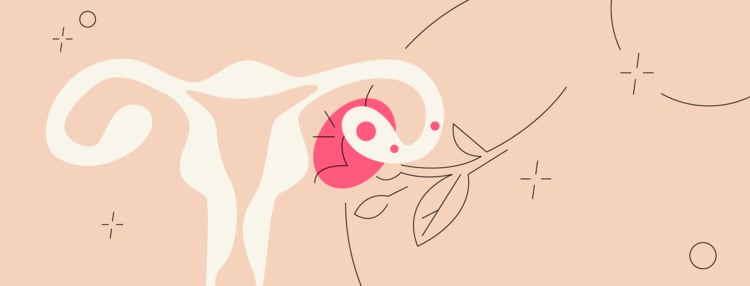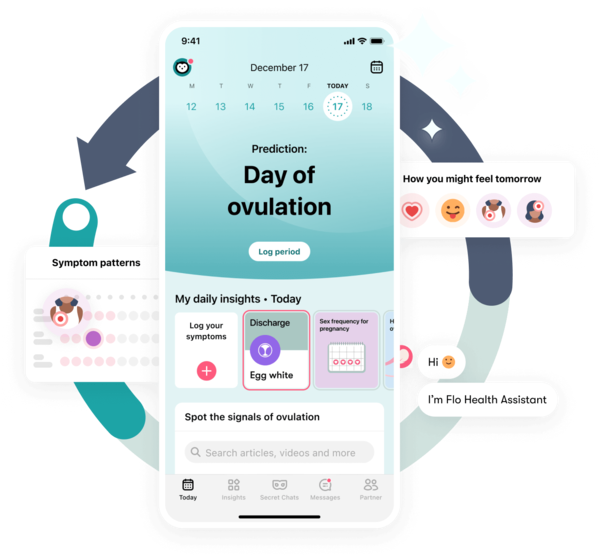The ovaries usually release just one egg during ovulation per menstrual cycle. But sometimes, more than one egg can mature and be released by an ovary in a process called hyperovulation, which can lead to getting pregnant with multiple babies. In this Flo article, we explain all about hyperovulation and multiple pregnancy, so keep reading to learn how it works!
-
Tracking cycle
-
Getting pregnant
-
Pregnancy
-
Help Center
-
Flo for Partners
-
Anonymous Mode
-
Flo app reviews
-
Flo Premium New
-
Secret Chats New
-
Symptom Checker New
-
Your cycle
-
Health 360°
-
Getting pregnant
-
Pregnancy
-
Being a mom
-
LGBTQ+
-
Quizzes
-
Ovulation calculator
-
hCG calculator
-
Pregnancy test calculator
-
Menstrual cycle calculator
-
Period calculator
-
Implantation calculator
-
Pregnancy weeks to months calculator
-
Pregnancy due date calculator
-
IVF and FET due date calculator
-
Due date calculator by ultrasound
-
Medical Affairs
-
Science & Research
-
Pass It On Project New
-
Privacy Portal
-
Press Center
-
Flo Accuracy
-
Careers
-
Contact Us
What Is Hyperovulation? How a Multiple Pregnancy Happens Naturally


Every piece of content at Flo Health adheres to the highest editorial standards for language, style, and medical accuracy. To learn what we do to deliver the best health and lifestyle insights to you, check out our content review principles.
When fraternal twins are conceived naturally (without fertility treatments), it’s because two eggs were fertilized by sperm in a single menstrual cycle. There’s only one way this can happen: multiple ovulation, AKA hyperovulation.
Multiple ovulation, or hyperovulation, occurs when both ovaries release an egg or when more than one egg is released by an ovary (it can be either ovary). You can predict when you're likely to be ovulating each month with our online ovulation calculator, but how often can hyperovulation happen?
How common is hyperovulation?
Researchers have studied ovulation and found that people may release more than one egg more often than previously thought. A 2003 Canadian study published in the British Medical Journal found that 40 percent of 63 participants had the potential to produce more than one egg in any given month.
Another 2003 study, published in the journal Fertility and Sterility, found that 68 percent of 50 participants had two different waves of follicle development during their cycle, and 32 percent had three. Follicles are fluid-filled sacs that mature into eggs when there’s a surge of luteinizing hormone (LH). This means that if someone has a specific hormone balance, ovulation could potentially happen multiple times, and that person could be fertile at any time of the month.
Symptoms and signs of hyperovulation
Hyperovulation can’t be easily detected using ovulation kits. The only way to tell for sure if you’re hyperovulating is through an ultrasound. A sign of hyperovulation could also be more white, stretchy vaginal discharge.
Take a quiz
Find out what you can do with our Health Assistant

Hyperovulation after miscarriage
It’s possible to ovulate and get pregnant as soon as two weeks after a miscarriage. While some sources state that fertility goes up after pregnancy loss, studies show mixed findings.
One 2003 study found a positive relationship between miscarriage and fertility, while a 2005 study had conflicting findings. Some people in online forums discuss the link between hyperovulation after miscarriage and an increased chance of having twins or baby triplets, but so far, there isn’t scientific research to support this.
Hyperovulation and multiple pregnancies
Wondering how to get triplets or even quadruplets?
A multiple pregnancy can happen due to hyperovulation, but it’s not the only way. Identical twins are formed when one egg is fertilized and then it splits, creating two fetuses with identical DNA. In vitro fertilization (IVF) treatment is another cause of multiple pregnancies, if more than one embryo is transferred into the uterus.
In recent decades, there’s been a growing rate of multiple pregnancies, partially due to the rise in fertility treatments. According to the National Center for Health Statistics, U.S., the twin birth rate has risen by a whopping 70 percent since 1980: It’s now over 32 per 1,000 births. There’s been an even greater increase in triplet, quadruplet, and higher-order multiple births.
Twins happen naturally in about 1 out of 250 pregnancies; triplets in about 1 in 10,000 pregnancies; and quadruplets in about 1 in 700,000 pregnancies.
Although it’s rare, it’s also possible to have identical multiples if there’s more than one fertilized egg and then they split, resulting in two different sets of identical twins.
While it’s definitely exciting to be pregnant with multiple babies, it does come with a few extra risks to be aware of. As the number of fetuses increases, so does the chance of preterm birth and needing a C-section, along with a few other potential complications.
Factors that might increase the odds of having multiples
Many things can increase your likelihood of having a multiple pregnancy, but it’s mostly genes and environmental factors:

— Genes: According to several studies, including one published in The Journal of Clinical Endocrinology & Metabolism in 1998, some people naturally have a higher level of FSH (follicle stimulating hormone) or release FSH more often. This means that more than one follicle can become dominant in any given cycle, leading to more than one egg being released. Also, if someone who can get pregnant has a family history of multiple pregnancies, they have greater odds of getting pregnant with more than one baby at once.
— Age: People over 30 have a greater chance of multiple pregnancy because FSH hormone levels rise with age.
— Ethnic background: Black women are more likely to have twins than any other ethnic group. Asians and Native American women are the least likely to have a multiple pregnancy. White women have the highest rate of having more than two babies at once.
— Height and weight: Taller women (above 5’4” or 164.8 cm) are more likely to have twins, according to a 2006 study published in the Journal of Reproductive Medicine. Having a BMI of 30 or more also increases the odds of twins, according to a 2005 study published in the Journal of Obstetrics and Gynecology.
— Past pregnancy: Having one or more previous pregnancies, especially if it was a multiple pregnancy, increases the chance of having multiples.
— Breastfeeding: If someone conceives while breastfeeding, the odds of having twins increases (11.4 percent vs. 1.1 percent), according to a 2001 study published in the Journal of Reproductive Medicine.
— Diet: Eating dairy products is associated with a higher rate of having twins (five times higher than vegans), according to a 2006 study published in the Journal of Reproductive Medicine.
— Fertility medication: Using drugs to cause ovulation often causes more than one egg to be released, and can result in twins, triplets, and higher-order multiples.
— Stopping birth control: Soon after stopping birth control, it’s thought that the ovaries release multiple eggs, increasing the odds of a multiple pregnancy, according to a 1977 study published in the New England Journal of Medicine.
— Assisted reproductive technology: IVF can also lead to multiple pregnancies, because more than one embryo may be transferred into the womb to increase the likelihood of implantation. Anywhere from 20–30 percent of successful IVF treatments result in twins.
How many babies can a person with hyperovulation have in one pregnancy?
Multiple births with more than three babies are very rare, and they’re usually due to fertility treatments rather than hyperovulation.
But in May 2021, a 25-year-old Malian woman gave birth to nine children, and she reportedly conceived without the help of fertility treatment. This is exceptionally rare and likely the result of a combination of hyperovulation and identical multiples.
While those babies remain under observation, the current Guinness World Record for the most surviving babies delivered in one birth is held by a U.S. woman, known as “Octomom.” This pregnancy was the result of IVF treatment that implanted 12 embryos.
Conclusion
If you’ve ever wondered how multiples are formed, one way is hyperovulation: a rare occurrence where the ovaries release more than one egg, and they all get fertilized. Hyperovulation happens when multiple follicles mature into eggs and are released by the ovaries, and the gene for it may run in your family. And thanks to the current rise in fertility treatments, people are getting pregnant with multiple babies more than ever.


Hey, I'm Anique
I started using Flo app to track my period and ovulation because we wanted to have a baby.


The Flo app helped me learn about my body and spot ovulation signs during our conception journey.


I vividly
remember the day
that we switched
Flo into
Pregnancy Mode — it was
such a special
moment.
Real stories, real results
Learn how the Flo app became an amazing cheerleader for us on our conception journey.
References
History of updates
Current version (24 August 2021)
Published (25 August 2021)
In this article

Get your personal guide to fertility
-
Learn how to read your body's ovulation signals
-
Find daily conception tips from our experts
-
Chat with others who are trying to get pregnant




